UF Ob/Gyn Residents Become First in U.S. to Earn ISUOG Certification
The University of Florida has set a new standard for ultrasound training while paving a new path for resident Ob/Gyn physicians in the United States. Thanks to…
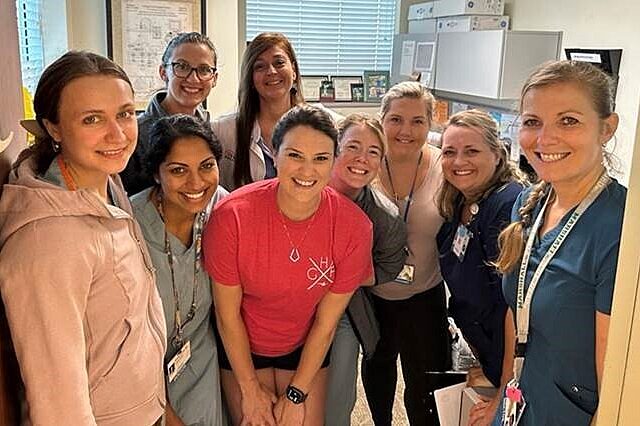
Update your location to show providers, locations, and services closest to you.
Osteoporosis is a disease in which bones become fragile and more likely to break (fracture).
Thin bones; Low bone density; Metabolic bone disease; Hip fracture - osteoporosis; Compression fracture - osteoporosis; Wrist fracture - osteoporosis
Osteoporosis is the most common type of bone disease.
Osteoporosis increases the risk of breaking a bone. About one half of all women over the age of 50 will have a fracture of the hip, wrist, or vertebra (bones of the spine) during their lifetime. Spine fractures are the most common.
Your body needs the minerals calcium and phosphate to make and keep healthy bones.
Sometimes, bone loss occurs without any known cause. Other times, bone loss and thin bones run in families. In general, white, older women are the most likely to have bone loss.
Brittle, fragile bones can be caused by anything that makes your body destroy too much bone, or keeps your body from making enough new bone. As you age, your body may reabsorb calcium and phosphate from your bones instead of keeping these minerals in your bones. This makes your bones weaker.
A major risk is not having enough calcium to build new bone tissue. It is important to eat/drink enough high-calcium foods. You also need vitamin D, because it helps your body absorb calcium. Your bones may become brittle and more likely to fracture if:
Other causes of bone loss include:
Other risk factors include:
There are no symptoms in the early stages of osteoporosis. Many times, people will have a fracture before learning they have the disease.
Fractures of the bones of the spine can cause pain almost anywhere in the spine. These are called compression fractures. They often occur without an injury. The pain occurs suddenly or slowly over time.
There can be a loss of height (as much as 6 inches or 15 centimeters) over time. A stooped posture or a condition called a dowager's hump may develop.
A DEXA scan is a low-radiation x-ray that measures the density of the minerals in your bones. Most often, it measures density in the spine and hip bones. Your health care provider uses this test to:
A simple spine or hip x-ray may show fracture or collapse of the spinal bones. However, simple x-rays of other bones are not very accurate in predicting whether you are likely to have osteoporosis. A new low-radiation spine x-ray called a vertebral fracture assessment (VFA) is now often done with a DEXA to better identify fractures that do not have any symptoms.
You may need blood and urine tests if your provider thinks the cause of your osteoporosis is a medical condition, rather than the slow bone loss that occurs with aging.
DEXA scan results compare your bone mineral density with both a young adult who has no bone loss and with people your age and sex. This means that at age 80, almost one third of women with normal age-related bone loss would have osteoporosis, based on their DEXA scan results.
Treatment for osteoporosis may involve:
Medicines are used to strengthen bones when:
Medicines used to treat osteoporosis include:
The length of time a woman needs to take these medicines depends on her level of risk. Recommendations include:
Exercise plays a key role in preserving bone density in older adults. Some of the exercises recommended to reduce your chance of a fracture include:
Avoid any exercise that presents a risk of falling. Also, do not do high-impact exercises that can cause fractures in older adults.
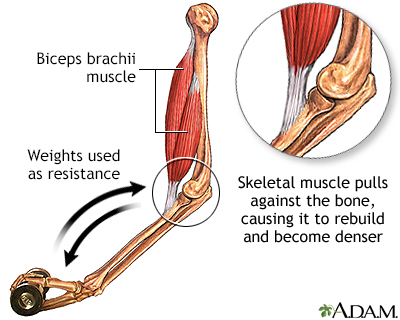
Follow these guidelines for getting enough calcium and vitamin D:
(Note: Some expert groups are not sure the benefits and safety of these amounts of vitamin D and calcium outweigh their risks. Be sure to discuss with your provider whether supplements are a good choice for you.)

Stop unhealthy habits:
It is important to prevent falls by older people. These suggestions can help:
Surgery to treat severe, disabling pain from spinal fractures due to osteoporosis include:
Medicines to treat osteoporosis can help prevent future fractures. Spine bones that have already collapsed can't be made stronger.
Osteoporosis can cause a person to become disabled from weakened bones. Hip fractures are one of the main reasons people are admitted to nursing homes.
Be sure you get enough calcium and vitamin D to build and maintain healthy bones. Following a healthy, well-balanced diet can help you get these and other important nutrients.
Other tips for prevention:
Medicines can treat osteoporosis and prevent fractures. Your provider can tell you if any are right for you.
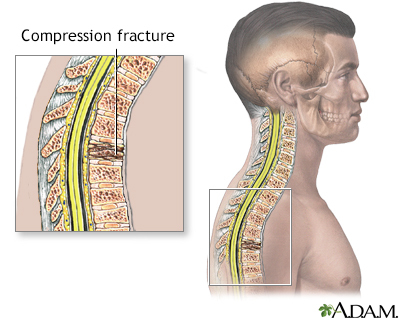

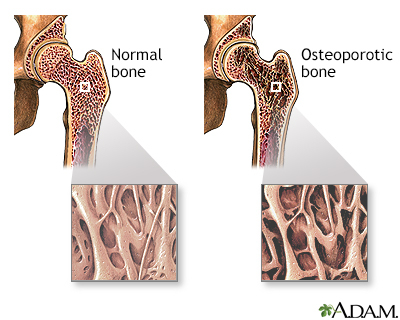
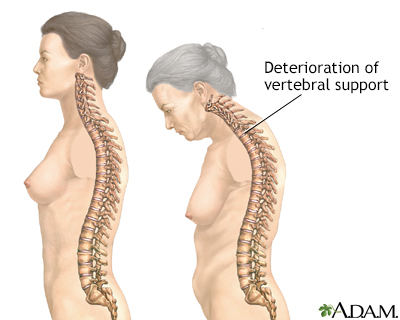
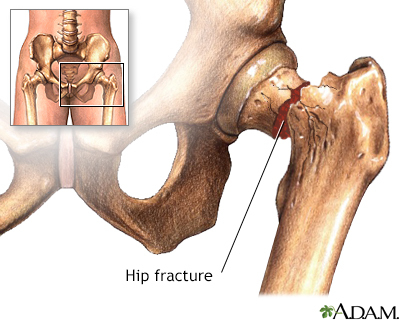
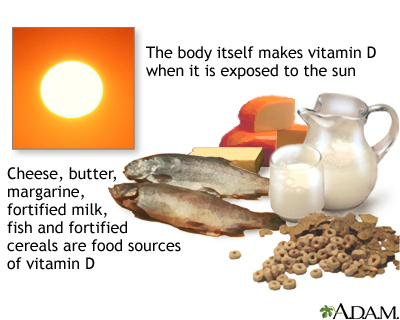
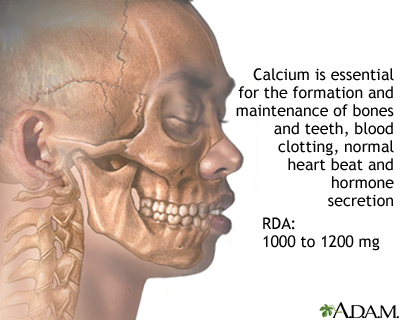
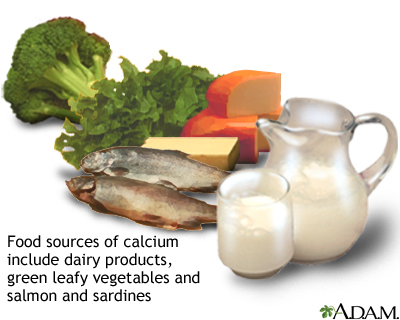

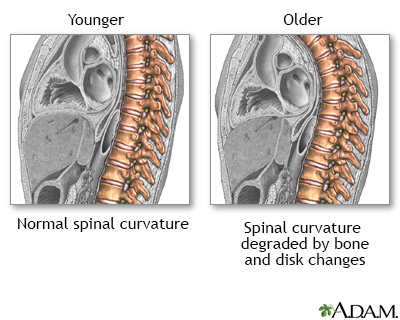
Compston JE, McClung MR, Leslie WD. Osteoporosis. Lancet. 2019;393(10169):364-376. PMID: 30696576 pubmed.ncbi.nlm.nih.gov/30696576/.
De Paula FJA, Black DM, Rosen CJ. Osteoporosis: basic and clinical aspects. In: Melmed S, Auchus RJ, Goldfine AB, Loenig RJ, et al, eds. Williams Textbook of Endocrinology. 14th ed. Philadelphia, PA: Elsevier; 2020:chap 30.
Eastell R, Rosen CJ, Black DM, et al. Pharmacological management of osteoporosis in postmenopausal women: an Endocrine Society* clinical practice guideline. J Clin Endocrinol Metab. 2019;104(5):1595-1622. PMID: 30907593 pubmed.ncbi.nlm.nih.gov/30907953/.
Kemmler W, Bebenek M, Kohl M, von Stengel S. Exercise and fractures in postmenopausal women. Final results of the controlled Erlangen Fitness and Osteoporosis Prevention Study (EFOPS). Osteoporos Int. 2015;26(10):2491-2499. PMID: 25963237 pubmed.ncbi.nlm.nih.gov/25963237/.
LeBoff MS, Greenspan SL, Insogna KL, et al. The clinician's guide to prevention and treatment of osteoporosis. Osteoporos Int. 2022 Apr 28. Epub ahead of print. PMID: 35478046. pubmed.ncbi.nlm.nih.gov/35478046/.
Qaseem A, Forciea MA, McLean RM, et al. Treatment of low bone density or osteoporosis to prevent fractures in men and women: a clinical practice guideline update from the American College of Physicians. Ann Intern Med. 2017;166(11):818-839. PMID: 28492856 pubmed.ncbi.nlm.nih.gov/28492856/.
US Preventive Services Task Force, Grossman DC, Curry SJ, Owens DK, et al. Vitamin D, calcium, or combined supplementation for the primary prevention of fractures in community-dwelling adults: US Preventive Services Task Force Recommendation Statement. JAMA. 2018;319(15):1592-1599. PMID: 29677309 pubmed.ncbi.nlm.nih.gov/29677309/.
The University of Florida has set a new standard for ultrasound training while paving a new path for resident Ob/Gyn physicians in the United States. Thanks to…

A former nurse practitioner at UF Health, Peggy had severe osteoporosis and was no stranger to chronic pain. A car crash in July 2017 exacerbated her distress.
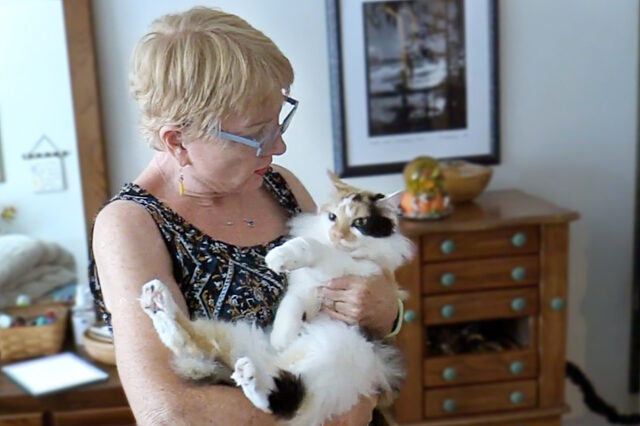
For many Americans, yoga is a relaxing activity that provides a variety of health benefits. Most notable are enhanced cardiovascular health, weight reduction and improved respiration. But for the...
Did your husband “forget” to do the dishes again? Tired of scrubbing the tub, doing the laundry and mopping that dirty kitchen floor? Now women have more arsenal for the next time they have to nag...
Did your husband “forget” to do the dishes again? Tired of scrubbing the tub, doing the laundry and mopping that dirty kitchen floor? Now women have more arsenal for the next time they have to nag...